Antigone
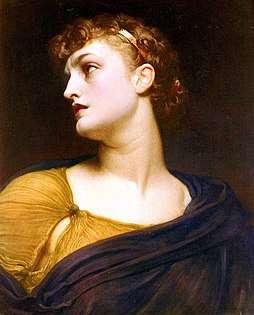
In Greek mythology, Antigone (/ænˈtɪɡəni/ ann-TIG-ə-nee; Greek: Ἀντιγόνη) is the daughter of Oedipus and his mother Jocasta. The meaning of the name is, as in the case of the masculine equivalent Antigonus, "worthy of one's parents" or "in place of one's parents".
Mythology
.svg.png)
Antigone is the subject of a story in which she attempts to secure a respectable burial for her brother Polynices. Oedipus's sons, Eteocles and Polynices, had shared the rule jointly until they quarrelled, and Eteocles expelled his brother. In Sophocles' account, the two brothers agreed to alternate rule each year, but Eteocles decided not to share power with his brother after his tenure expired. Polynices left the kingdom, gathered an army and attacked the city of Thebes in a conflict called the Seven Against Thebes. Both brothers were killed in the battle.
King Creon, who has ascended to the throne of Thebes after the death of the brothers, decrees that Polynices is not to be buried or even mourned, on pain of death by stoning. Antigone, Polynices' sister, defies the king's order but is caught.
In the oldest version of the story, the burial of Polynices takes place during Oedipus' reign in Thebes, before Oedipus marries his mother, Jocasta. However, in other versions such as Sophocles' tragedies Oedipus at Colonus and Antigone, it occurs in the years after the banishment and death of Oedipus and Antigone's struggles against Creon.
Antigone is brought before Creon, and admits that she knew of Creon's law forbidding mourning for Polynices but chose to break it, claiming the superiority of divine over human law, and she defies Creon's cruelty with courage, passion and determination.
Sophocles' Antigone ends in disaster. Creon orders Antigone buried alive in a tomb. Although Creon has a change of heart and tries to release Antigone, he finds she has hanged herself. Creon's son Hæmon, who was in love with Antigone commits suicide with a knife, and his mother Queen Eurydice, also kills herself in despair over her son's death. She has been forced to weave throughout the entire story, and her death alludes to The Fates.
Sophocles' play is a typical Greek tragedy, in which inherent flaws of the acting characters lead to irrevocable disaster. Antigone and Creon are prototypical tragic figures in an Aristotelian sense, as they struggle towards their fore-doomed ends, forsaken by the gods.
Euripides' lost story
The dramatist Euripides also wrote a play called Antigone, which is lost, but some of the text was preserved by later writers and in passages in his Phoenissae. In Euripides, the calamity is averted by the intercession of Dionysus and is followed by the marriage of Antigone and Hæmon.[1] Antigone also plays a role in Euripides' extant play The Phoenician Women.
Appearance elsewhere
Different elements of the legend appear in other places. A description of an ancient painting by Philostratus (Imagines ii. 29) refers to Antigone placing the body of Polynices on the funeral pyre, and this is also depicted on a sarcophagus in the Villa Doria Pamphili in Rome. And in Hyginus' version of the legend, founded apparently on a tragedy by some follower of Euripides, Antigone, on being handed over by Creon to her lover Hæmon to be slain, is secretly carried off by him and concealed in a shepherd's hut, where she bears him a son, Maeon. When the boy grows up, he attends some funeral games at Thebes, and is recognized by the mark of a dragon on his body. This leads to the discovery that Antigone is still alive.[1] The demi-god Heracles then intercedes and pleads with Creon to forgive Hæmon, but in vain. Hæmon then kills Antigone and himself.[2] The intercession by Heracles is also represented on a painted vase (circa 380–300 BC).[3][4]
Gallery
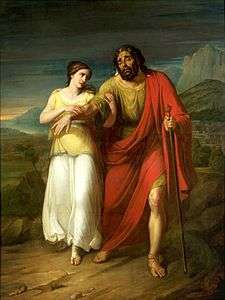 Oedipus and Antigone by Aleksander Kokular (1825–1828), National Museum, Warsaw
Oedipus and Antigone by Aleksander Kokular (1825–1828), National Museum, Warsaw.png) Oedipe et Antigone by Johann Peter Krafft, 1809
Oedipe et Antigone by Johann Peter Krafft, 1809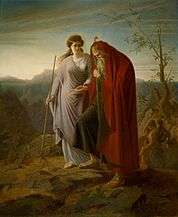 Oedipus and Antigon by Franz Dietrich
Oedipus and Antigon by Franz Dietrich Oidipus a Antigona by Hans Knoechl (1883)
Oidipus a Antigona by Hans Knoechl (1883).jpg) Oedipus and Antigone by C. W. Eckersberg (1812)
Oedipus and Antigone by C. W. Eckersberg (1812) Oedipus and Antigone by Per Wickenberg (1833)
Oedipus and Antigone by Per Wickenberg (1833)- Edipo y Antigona by José Ribelles (circa 1800)
 Oedipus and Antigone by Charles Jalabert (1842)
Oedipus and Antigone by Charles Jalabert (1842) Oedipus and Antigon
Oedipus and Antigon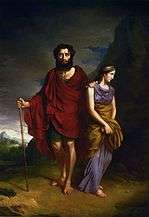 Oedipus and Antigon by Antoni Brodowski (1828)
Oedipus and Antigon by Antoni Brodowski (1828)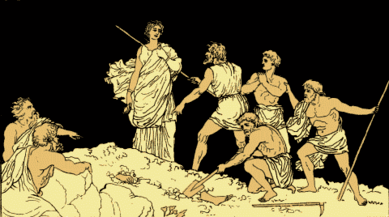 Antigone and the body of Polynices (Project Gutenberg)
Antigone and the body of Polynices (Project Gutenberg) Ödipus (mit Ismene und Antigone) verurteilt Polyneikes by Marcel Baschet (1883)
Ödipus (mit Ismene und Antigone) verurteilt Polyneikes by Marcel Baschet (1883)_(14784688512).jpg) Antigone and Ismene
Antigone and Ismene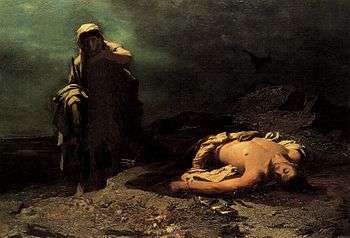 Antigone in front of the dead Polynices by Nikiforos Lytras (1865)
Antigone in front of the dead Polynices by Nikiforos Lytras (1865)- Antigone donnant la sépulture à Polynice by Sébastien Norblin (1825)
Cultural references
Adaptations
The story of Antigone has been a popular subject for books, plays, and other works, including:
- Antigone, one of the three extant Theban plays by Sophocles (497 BC – 406 BC), the most famous adaptation
- Antigone, a play by Euripides (c. 480 – 406 BC) which is now lost except for some fragments
- Antigona , opera by Tommaso Traetta, libretto by Marco Coltellini (1772)
- Antigona, opera by Josef Mysliveček, libretto by Gaetano Roccaforte (1774)
- Antigone (1841), settings of the choruses by Felix Mendelssohn as incidental music for a performance of Johann Jakob Christian Donner's translation of Sophocles
- Antigone, play by Jean Cocteau (1889–1963)
- Antigone, opera by Arthur Honegger (1892-1955), libretto by Jean Cocteau (1889–1963)
- Antigone, opera by Carl Orff (1895–1982)
- Antigone, play by Jean Anouilh (1910–1987)
- "Antigone-Legend", for soprano and piano (text by Bertolt Brecht), by Frederic Rzewski (b. 1938)
- Αντιγόνη (Antigone), ballet[5] by Mikis Theodorakis (b. 1925), 1959
- Αντιγόνη (Antigone), opera by Mikis Theodorakis (b. 1925),1995–96
- Antigone (1990/1991), opera by Ton de Leeuw (b. 1926)
- Antígona Furiosa (Furious Antigone), play by Griselda Gambaro (b. 1928)
- Another Antigone, play by A. R. Gurney (b. 1930)
- The Island, play by Athol Fugard (b. 1932)
- La Pasión Según Antígona Pérez ((The) Passion according to Antigone Pérez), adaptation by Luis Rafael Sánchez (b. 1936), updated to 20th-century Latin America
- Antígona, play by Salvador Espriu (1939)
- Tegonni, An African Antigone by Femi Osofisan (b. 1946)
- Antigone, adaptation of Sophocles' play by Peruvian poet José Watanabe (b. 1946)
- Antigone, opera by Mark Alburger (b. 1957)
- Antigone, comic book by David Hopkins (b. 1977)
- Antigone, opera by Vassily Lobanov, libretto by Alexey Parin (1988)
- Antigone by Henry Bauchau
- Antigone's Red (2002), short play by Chiori Miyagawa
- The Burial at Thebes (2004), by Seamus Heaney, adapted into a 2008 opera with music by Dominique Le Gendre
- Antigone, play by Mac Wellman
- Antígona Vélez (1950), adaptation of Sophocles' play by Argentinean writer Leopoldo Marechal (1900–1970)
- Antigonai (2009), opera based on fragments by Sophocles and Hölderlin for three choirs and a women's trio by Argentine composer Carlos Stella
- Antigone's Song (2010), short post-apocalyptic musical western film based loosely on the myth of Antigone by Perpombellar Productions
- Antigone, by Bertolt Brecht, based on the translation by Friedrich Hölderlin and published under the title Antigonemodell 1948[6]
- Antigone, play by Antonio D'Alfonso (2004)
- Antigone, play by Don Taylor[7]
- Antigone, modern adaptation (87 minute film) by Antonio D'Alfonso (2012)
- Antigonick, play by Anne Carson (2012)
- Antigonas, linaje de hembras, play by Argentinean playwright Jorge Huertas
- Antigone, play by Theodora Voutsa (2016) at Compagnietheater in Amsterdam
- Antigona (1960), a play by Dominik Smole
- The Children of Jocasta (2017), a novel by Natalie Haynes
- Home Fire (2017), a novel by Kamila Shamsie
- Antigone (2017), a film artwork by Tacita Dean
- Antigone in Molenbeek (2017) a play by Stefan Hertmans
Writings on
In the works of Hegel, in particular in his discussion of Sittlichkeit in his Phenomenology of Spirit and his Elements of the Philosophy of Right, Antigone is figured as exposing a tragic rift between the so-called feminine "Divine Law," which Antigone represents, and the "Human Law," represented by Creon. The psychoanalyst Jacques Lacan writes about the ethical dimension of Antigone in his Seminar VII, The Ethics of Psychoanalysis. Others who have written on Antigone include theorist Judith Butler, in her book Antigone's Claim, as well as philosopher Slavoj Žižek, in various works, including Interrogating the Real (Bloomsbury: London, 2005) and The Metastases of Enjoyment (Verso: London, 1994).
Contemporary productions
A new translation of Antigone into English by the Canadian poet Anne Carson has been used in a production of the play produced by BAM (Brooklyn Academy of Music) and put on at the BAM Harvey Theatre in Brooklyn, New York. The performance featured Juliette Binoche as Antigone, with Ivo van Hove as the director. The play ran from September 24 to October 4, 2015.[8]
References
- 1 2

- ↑ Scott Smith, R.; Trzaskoma, Stephen; Pseudo-Apollodorus; Hyginus (2007). Apollodorus' Library and Hyginus' Fabulae: two handbooks of Greek mythology. Indianapolis: Hackett Publishing. p. 122. ISBN 978-0-87220-820-9.
- ↑ Heydermann, Heinrich (1868). Über eine nacheuripideische Antigone [On a post-Euripideian Antigone] (in German). Berlin: Adolph Enslin. ISBN 978-1-160-28969-6. OCLC 601932362.
- ↑ Sophocles; Jebb, R. C. (1890). Sophocles: The Plays and Fragments. Cambridge: CUP Archive.
- ↑ commissioned by the Royal Ballet, 1959
- ↑ Brecht, Bertolt (1948). Antigonemodell 1948 (in German). Berlin: Gebrüder Weiss Verlag. LCCN 50056426. OCLC 1456885.
- ↑ Charles Spencer (31 May 2012). "Antigone, National Theatre, review". Telegraph.co.uk.
- ↑ Antigone at Brooklyn Academy of Music.
Further reading
| Wikimedia Commons has media related to Antigone. |
- Antigones by George Steiner. An examination of the legacy of the myth and its treatment in Western art, literature, and thought in drama, poetry, prose, philosophic discourse, political tracts, opera, ballet, film, and even the plastic arts.Steiner, George (October 1996). Antigones – How the Antigone Legend Has Endured in Western Literature, Art, and Thought. New Haven: Yale University Press. ISBN 978-0-300-06915-0. LCCN 96060411. OCLC 318365852.
- Antigone's Claim: Kinship Between Life and Death by Judith Butler. An examination of the figure of Antigone in literature and philosophy, particularly in Sophocles and in the work of Georg Wilhelm Friedrich Hegel, Luce Irigaray and Jacques Lacan.Butler, Judith (2000). Antigone's Claim: Kinship Between Life and Death. The Wellek Library lectures. New York: Columbia University Press. p. 88. ISBN 978-0-231-11895-8. OCLC 43951993. Retrieved 24 May 2011.
- Rayor, Diane J. (2011) Sophocles’ Antigone. Cambridge University Press. Translation with introduction and notes.
- Söderbäck, Fanny, ed. Feminist Readings of Antigone. New York: SUNY Press, 2010. ISBN 978-1-4384-3278-6. Including classical texts by Judith Butler, Bracha Ettinger, Julia Kristeva, Luce Irigaray and Adriana Cavarero.
- Wilmer, S. E., and Zukauskaite, Audrone, eds. Interrogating Antigone. Oxford: Oxford University Press, 2010. ISBN 978-0-19-955921-3. Including recent texts by Judith Butler, Bracha L. Ettinger, Julia Kristeva and Luce Irigaray.